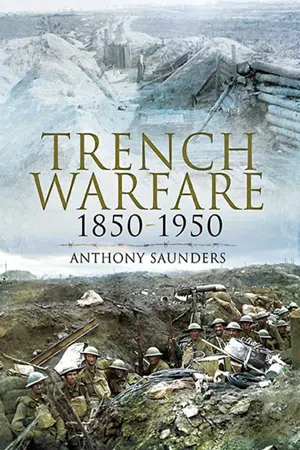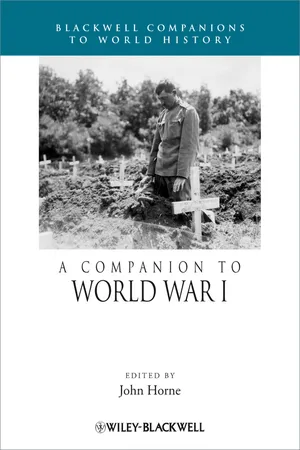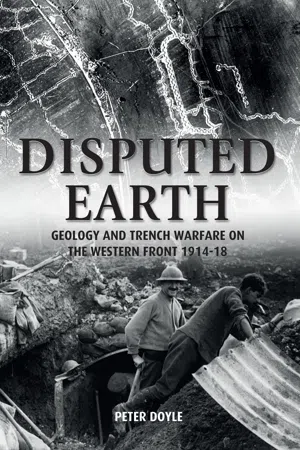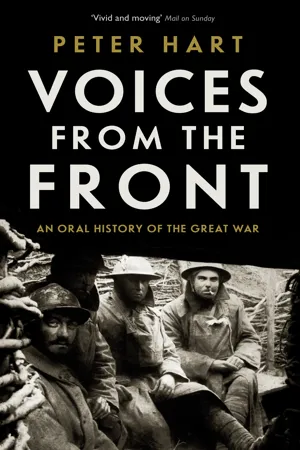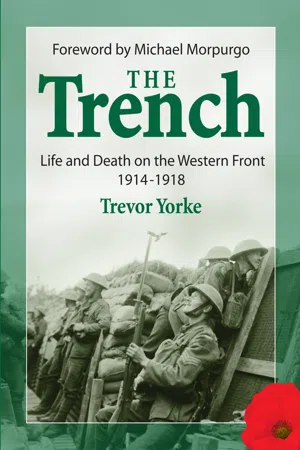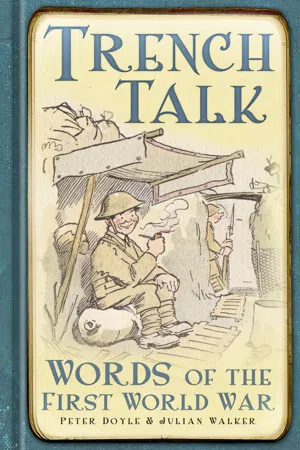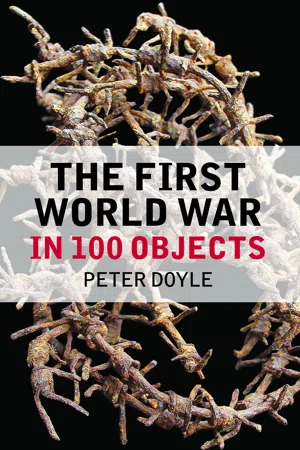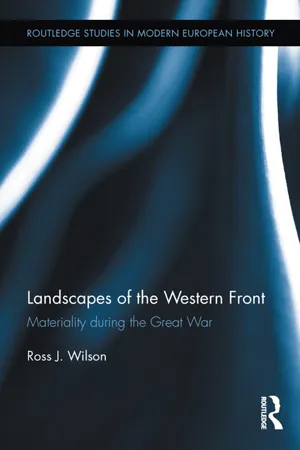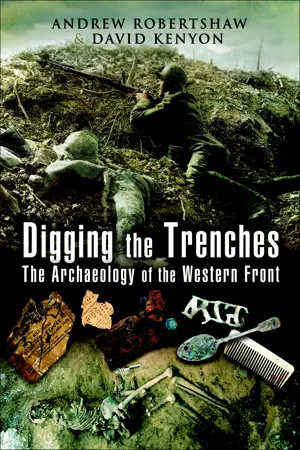History
Trench Warfare
Trench warfare was a military strategy used extensively during World War I, characterized by soldiers fighting from trenches dug into the ground. It involved a static, defensive approach with little movement and resulted in a stalemate on the Western Front. The harsh conditions in the trenches, including mud, disease, and constant threat of enemy attacks, made it a grueling and challenging form of warfare.
Written by Perlego with AI-assistance
Related key terms
Related key terms
1 of 4
Related key terms
1 of 3
10 Key excerpts on "Trench Warfare"
- eBook - ePub
- Anthony Saunders(Author)
- 2010(Publication Date)
- Pen & Sword Military(Publisher)
The emergence of Trench Warfare was not an aberration, as is sometimes thought, but part of a wider change in modes of warfare that took place over a period of about sixty years, in which technological, ideological, tactical and strategic issues all played their parts. Trench Warfare has been blamed on stupid army commanders, on technological advances and on technological failures, but the target of such criticism is usually aimed solely at the First World War rather than at Trench Warfare in a wider context. The most common misconception about Trench Warfare on the Western Front is that it was somehow avoidable and that the prolonged stalemate between 1914 and 1918 was the result of general incompetence. Had that been the case, all commanders in all armies engaged in the fighting would have suffered the same malaise for four years until, miraculously, a cure was suddenly plucked from the ether for the disease of Trench Warfare, then quickly administered to the warring armies so that movement was immediately restored to the stagnated soldiery. This is not what happened.Part of the problem lies in understanding the nature of Trench Warfare. After all, trenches and earthworks were essential features of both battle and siege for centuries, yet so-called Trench Warfare did not occur until the mid-nineteenth century, and did not become a dominant factor in warfare until the beginning of the twentieth. The question is: what differentiates traditional siege work, in which trenches figured prominently, and fighting that may be described as ‘Trench Warfare’? In other words, what is Trench Warfare?Trench Warfare is usually described as military operations between two entrenched armies. It is a form of stalemate in which neither side can breach or outflank the defences of the other so that breakthrough cannot be achieved, irrespective of the size or type of operation carried out to achieve that aim. In other words, it is mutual siege. The manner in which the fighting is conducted, and the nature of the weapons used and their numbers, all factor into the equation since these contribute to the stalemate and its intractability. If this were not the case, ‘Trench Warfare’ would have occurred in the eighteenth century. Clearly, there is a complex relationship between the various factors which, in the right balance, produce stalemate and, hence, Trench Warfare. In other words, there has to be a fluid balance between the opposing armies to prevent breakthrough in order for Trench Warfare to occur. - eBook - ePub
- John Horne(Author)
- 2011(Publication Date)
- Wiley-Blackwell(Publisher)
It was facilitated by the greater autonomy allowed to lower-level units backed up by a command structure that was capable of adapting rapidly in response to the lessons learned from battle experience. However, the German tactic did not prove decisive. In Trench Warfare the further each offensive pushed through the enemy’s defenses, the more its momentum diminished. The exhaustion of the waves of attacking troops, the inability to move artillery forward over terrain that had been destroyed by bombardment, and the enemy’s capacity to bring in reinforcements by lorry or train all contributed to the failure of every major attempt to break through the defensive trench systems on the western front. Each such attempt rapidly collapsed into unending, costly clashes, often drawn out over many months. The strategic impasse was only broken in the second half of 1918 owing to the combined effect of the exhaustion of all German manpower reserves, the new effective coordinated use of the tank and the airplane, and the demographic advantage that the Allies gained from the arrival of American troops. The trenches of 1914–18 had a major effect upon the Western tradition of combat, which was centered upon a form of very violent, but brief, confrontations that took place within a limited area: in other words the battle. 8 The “battles” of World War I pushed the definition of battle to the point of absurdity. The predominance of the defensive over the offensive meant that these were battles in name only. In reality, they were far closer to sieges in open country which used modernized versions of all the techniques that had been used in traditional siege warfare: lines of trenches which in a way acted as hollow ramparts, mines dug underneath enemy positions, grenades, artillery fired at a high angle with a steeply curved trajectory, etc. As with traditional sieges, the process took a very long time - eBook - ePub
Disputed Earth
Geology and Trench Warfare on the Western Front 1914–18
- Peter Doyle(Author)
- 2017(Publication Date)
- Uniform(Publisher)
4 GEOLOGY AND Trench WarfareThe line of trenches runs nearly everywhere through low-lying ground, intersected with watery ditches and small streams; the land is so level, and the atmosphere so heavy, that, as a rule, the eye ranges little further than the rifle bullet will carry.169A well-revetted German trench on the Western Front, c. 1916The Great War is Trench Warfare to many, yet it has a much longer history. In modern warfare, trenches all too often appeared due to the offensive capability of advanced weapons, with desire asserting itself to stop the war of movement by ‘digging in’ – thereby protecting the infantry and preserving their opportunity to attack again. But the use of trenches has a long history in siege warfare. Dating back to at least the seventeenth century, siege trenches were dug by an attacker in an attempt to protect their camp and works. Trenches and saps were thus built as a fortification to face a fortification, and were known as the ‘lines of circumvallation’.170 The recreation of the trench lines in late 1914 therefore owed much to at least two and a half centuries of application and development of the art of the military siege, rather than a new innovation, and produced parallel fortresses that were exceptionally difficult to destroy, and which in turn required powerful ‘siege weapons’ to attempt to do so. New ‘siege engines’ would be called upon in this age of industrial warfare.171Trenches may have reappeared often in history, but one thing was certain: that not all trenches were equal in value and effectiveness. Trenches could suffer enfilade fire – the opportunity for an enemy to fire along their length – which was in part due to the method of construction, and the position relative to topography. They could be exposed to observation and vulnerable for the same reason. Trenches could be perennially wet; they could be subject to collapse, or they could be exceptionally difficult to dig. These factors were to a large part controlled by the nature of ground, of the underlying geology. And if the armies that fought in the Great War had not expected Trench Warfare, then they would need to learn quickly how best to use it – and this would mean reaching out to the new science of geology in order to mitigate the various problems that presented themselves. It was as if Walter Kranz’s prediction of the importance of soldiers who really - eBook - ePub
Voices from the Front
An Oral History of the Great War
- Peter Hart(Author)
- 2015(Publication Date)
- Profile Books(Publisher)
41915: WESTERN FRONTTHE NEW YEAR BROUGHT A DAWNING REALISATION that the troglodyte existence of Trench Warfare would be the new normality for the foreseeable future. Trench systems were still relatively simple, but effective: they seemed almost impenetrable. From within the trench the defending infantry could shoot their rifles to maximum effect into advancing troops while at the same time being protected from any return fire. The strands of barbed wire strung out across No Man’s Land may have been scanty, but they were still effective in slowing the progress of attacking troops, at which point the machine guns added concentrated fire-power to the tactical mix, pouring bullets into their helpless targets. The employment of artillery was relatively primitive, yet infantry caught massing in the trenches, or crossing No Man’s Land, could be destroyed in a matter of moments.The Western Front became an impossible problem for the generals on both sides. How were they to break down this integrated system of defence? Ultimately what was needed was a means whereby the defending infantry and artillery could be prevented from firing while the attacking troops were exposed in the open. But this demanded a variety of sophisticated gunnery techniques and developments in armaments technology which would only appear as the ‘fruits’ of the science of war in the years to come. As a result, separated only by No Man’s Land, the great armies continued to sit in trenches that wound from Switzerland to the North Sea.The Battle of Neuve ChapelleThe British made their first real attempt to break through the German lines at Neuve Chapelle, when the First Army commanded by General Sir Douglas Haig attempted to pinch out the salient around the village. A heavy bombardment was intended to destroy the German front line: no less than 340 guns were concentrated along the 2,000-yard frontage to be assaulted by the IV and Indian Corps – a ratio of one gun for every 6 yards of front attacked. In this low-lying section of the front the German trenches were largely restricted to sandbag barricades, about 5 feet thick. The British guns were brought up in secrecy and registered their targets as unobtrusively as possible. It was also the first operation to utilise properly the potential of the RFC to photograph the sector to be assaulted, using the nascent art of photographic interpretation to reveal German artillery batteries, machine-gun posts and headquarters. - eBook - ePub
The Trench
Life and Death on the Western Front 1914-1918
- Trevor Yorke(Author)
- 2014(Publication Date)
- Countryside Books(Publisher)
Major Walter Gordon Wilson (right) were responsible for much of the design of this new vehicle. After the war they were singled out and rewarded for their work.The habits of the 19th century were quickly wiped away and new tactics and weapons introduced in a desperate race to make the crucial breakthrough. In the space of just over four years, the way in which the infantry and artillery were used radically changed to meet the demands of Trench Warfare while improved guns, bombs, aircraft, tanks, flamethrowers and poison gas changed the face of warfare forever.Tactics
Trench Warfare came about because advances in weaponry were not matched by the same progress in mobility. German rapid-fire guns and new heavy artillery were aimed at the British, who were still moving around as if on a parade ground. Although tanks and aircraft which would later reverse this imbalance were available, their abilities were not fully appreciated and the tactics applicable to them still needed to be developed. Another reason why Trench Warfare developed was that once the Western Front formed a continuous line to the coast there were no flanks to get around the side of the enemy. This meant that most advances had to be made directly towards the enemy line. Soldiers and their commanders had been trained to expect a mobile war. As the conflict degenerated into a stalemate they had to develop a whole new approach to warfare.CavalryAlthough many had warned that the days of cavalry as a fighting force were numbered, they were still seen as an important part of the British forces at the outbreak of war. The power of the charge was considered a valuable weapon and it was believed that they could exploit gaps made in enemy defences with their speed. This proved tragically wrong along the Western Front as the horses were simply mown down by machine gun fire and artillery. However, as the area rapidly turned into a mud bath horses proved invaluable in moving artillery and supplies with hundreds of thousands brought from around Britain or imported from as far away as New Zealand. Horse feed was the single largest commodity imported into France during the conflict, and British veterinary hospitals which were established there, returned half a million animals back to health. The tank and armoured vehicles with caterpillar tracks eventually made it unnecessary to pluck these noble beasts from peaceful farm duties and throw them into the horror and torture of the war zone, as depicted in Michael Morpurgo’s War Horse - eBook - ePub
Trench Talk
Words of the First World War
- Peter Doyle, Julian Walker(Authors)
- 2011(Publication Date)
- The History Press(Publisher)
N THE TRENCHEST he trench was the focal location of the war. Simply, the trenches of the Great War were linear excavations of variable depth mostly open to the sky, and their purpose was to provide protection to the frontline troops from small arms fire and artillery. For the most part, trenches were 6–8ft deep, although this was the ideal as in some cases it was impossible to dig more than a foot or so before reaching water-saturated ground, especially in the Ypres Salient with its underlying foundation of water-repelling clay. Here, instead, the trenches were built-up with sandbags rather than dug down.Most trenches were ‘floored’ with wooden duckboards (or ‘bathmats’), which were built up to allow drainage beneath. Trench sides (known as slopes) were supported or revetted with whatever was available, sometimes wattle, often corrugated sheeting and expanded metal (‘xpm’), and even with chicken wire. Timber was used universally to hold these materials in place, and layers of bonded sandbags strengthened the whole. Sandbags were to become an important part of trench life, filling gaps in the line, creating a parapet or ultimately being built upwards as breastworks.Fire trenches were usually arranged in successive parallel rows, with the frontline, support line and reserve line all connected by the communication trenches (‘CTs’), which were the main thoroughfares of Trench Warfare. The purpose of ‘CTs’ was to link the forward or fire trenches, and to allow men, munitions and supplies to travel up to the line – as well as allowing wounded soldiers to come out of the line. In well-established trench systems, the frontline consisted of a fire trench and ancillary support trench with deeper dug-outs providing accommodation for the troops. Trench signboards were fixed to allow newcomers to a particular stretch to get oriented, and trenches were named or numbered – a complex system recorded on equally complex trench maps. - eBook - ePub
- Peter Doyle(Author)
- 2014(Publication Date)
- The History Press(Publisher)
The development of this type of Trench Warfare was an inevitable consequence of the improvement in weaponry, and in particular rifled weaponry, which could fire – with great accuracy, range and velocity – projectiles from as small as the rifle bullet to as large as the artillery shell. Unprotected, the infantryman was vulnerable to devastating firepower at longer ranges, and with the advent of quick-firing weapons such as the latest field guns and machine guns, the only way to ‘bite and hold’ a position was to ensure that men got to ground as soon as possible, digging into the earth to gain the maximum protection that could be afforded. Rifled weapons had contributed to the development of Trench Warfare in the American Civil War of 1861–65, which had gone from Napoleonic ranks to trench operations over its five years; and its appearance in modern warfare was heralded in the Russo-Japanese War of 1904–05.Excavations in Flanders in 2005 expose A-frames and corrugated iron revetments.In the First World War, entrenchment of the Western Front was an inevitable consequence of the fight for position that took place during the ‘Race for the Sea’ in the autumn and winter of 1914. From this point onwards the engineers of all the protagonists worked to develop and improve trench fortifications within unfavourable ground conditions, and to protect the infantry from both the attentions of the enemy and from the elements. The best positions were quickly taken and the lines set in position that would become the zone of Trench Warfare for some four long years.Engineer trench design needed consideration of ground conditions. The trench illustrated was one that was excavated in the Ypres Salient in 2005 and demonstrates in some detail how these specialist soldiers coped with the difficult ground – and show how unexpected challenges of extended siege warfare became a high science in itself. Recent archaeological studies in northern France and in Flanders have allowed scientists and historians to add further dimensions to our understanding of Trench Warfare provided by accounts, official histories and photographs. Here, engineers have tried to combat the inevitability of water collecting in the bottom of the trench, thereby promoting ‘trench feet’ – a condition akin to frostbite – as men struggled through the water-logged trench. Prefabricated wooden A-frames were sunk into the ground. The crossbar of the ‘A’ provides a support for an elevated walkway or duckboard. Water could accumulate below and could be drained away, if skilfully done. The rising timbers of the frame provided rigid support for the trench sides, known as slopes, which were important if the sides were not to collapse in on the trench garrison. This revetment differed from trench to trench, from army to army. In the case illustrated from the Ypres Salient, corrugated steel was used; however, sandbags, wattle hurdles, timber – all were tried according to whatever was available. Trench construction varied between nations – in many cases wattle was used as a natural revetment type. - eBook - ePub
Landscapes of the Western Front
Materiality During the Great War
- Ross Wilson(Author)
- 2013(Publication Date)
- Routledge(Publisher)
5 In the Trenches
INTRODUCTION
The battlefields and trenches were always central to the soldiers’ experiences of being stationed in France and Belgium. Despite the contacts with home, the activities set up by the General Staff and charitable organisations, as well as the attractions of life in the cities, towns and villages in another country, moving ‘up the line’ was still the occupation that governed their lives. Within the spaces of the trenches, dugouts and the battlefield landscape of no-man’s-land the soldiers moved through and attributed a ‘sense of place’ and meaning. These areas were imbued with values and associations that reflected the soldiers’ lives, their experiences and their perceptions. Alongside these processes of meaning-making and acclimatising to a very different and potentially hostile place, the trenches were also spaces which were highly governed and organised. Within this area the soldiers’ lives were rigorously monitored and structured by the General Staff to ensure that the ‘fighting spirit’ was maintained within the ranks. Therefore, the area of the front line was itself a multilayered phenomenon. As the landscape of the battlefield was criss-crossed by the network of trenches, so too were the meanings of that war landscape. This specific space was overlaid with personal associations, military objectives and distinct social worlds for those who inhabited and fought in the area. Whereas the connections between the soldiers at the front and their families and friends in Britain were maintained by a variety of material, cultural and social ties, ‘the trenches’ were a unique experience for the soldiers of the British Army. From regulars, territorials, volunteers and conscripts the battlefield was the war that they knew.This specific experience of the war, of inhabiting the places and spaces of the conflict and handling the material of battle, marked this group of men as distinctive amongst themselves and how they perceived others around them. This was the distinctive feature of the war landscape: just as the soldiers of the British Army remade the battlefield using heavy artillery, digging new features into the earth and spreading barbed wire and debris across the countryside of France and Belgium, the battlefield in turn fashioned the soldiers who operated within it. This is a fundamental point of a variety of approaches of studying the relationships between individuals and groups and the places they inhabit (Relph 1976; Werlen 1993). It enables the study of understanding the network of associations and meanings that individuals create within the world around them. In this case, the reciprocal relationship between the soldiers and the war landscape produced further examples of the ‘war culture’ within the British Army. This formed a means for soldiers to endure the difficult conditions and the fluctuating extremes of being in the trenches. These fluctuations are aptly summarised by Peacock who describes in his memoirs the overwhelming experience of many soldiers in the British Army: - eBook - ePub
Encyclopedia of Warfare
From the Earliest Times to the Present Day
- Adrian Gilbert(Author)
- 2013(Publication Date)
- Routledge(Publisher)
Germany and Austria banded together as the Central Powers, and were opposed by Russia and France. The other remaining European great power, Britain, was hostile toward Germany, and, while it had an informal arrangement with France, it remained outside the formal alliance system. Italy, on the other hand, was formally allied with the Central Powers in 1914 but remained neutral until 1915 when it officially entered the war on the side of France and Britain.Trench Warfare, although not a new defensive tactic in battle, became the indelible symbol of World War I, especially along the Western Front. Here, French soldiers are dug in at Verdun, a battle that lasted nearly the whole of 1916 and claimed a million casualties.In August 1914, German troops marched into Belgium, as seen here entering Brussels. Although they progressed steadily at first, within a few months they became entrenched in a defensive line stretching from the English Chonnel in the north to Switzerland in the south. Both sides remained along this line, known as the Western Front, for the remainder of the war.The European alliances were initially intended to be essentially defensive in nature, but a series of international incidents – Morocco (1905), Bosnia (1908–09), and Agadir (1911) – increased tensions so much that the European powers became polarized into two armed camps. The army general staffs began to draw up plans for the probability of outright conflict.The strategic situation was geographically determined: Germany and Austria-Hungary held the center, “surrounded” by France and Russia, while Britain occupied a peripheral position. By 1912–13, Germany had become increasingly concerned by the rising economic might of Russia, its millions of miles of railroads – and therefore capability of transporting millions of soldiers relatively quickly – and the German General Staff began to advocate war before the Russian Army could take advantage of the relative decline in German industrial and military power. - eBook - ePub
Digging the Trenches
The Archaeology of the Western Front
- Andrew Robertshaw, David Kenyon(Authors)
- 2014(Publication Date)
- Pen & Sword Military(Publisher)
Once a soldier had been transported to the front, fed, clothed, equipped, armed and provided with a trench, he came to the ‘heart of the matter’: fighting the enemy. For the British and French at least this would sooner or later mean taking part in a major offensive. For the German soldier, unless he was involved in one of the relatively rare large-scale German attacks, such as at Verdun, his experience would be of waiting for the British or French to attack him. In between these large-scale offensives both sides kept up an active programme of raiding into the enemy’s trenches. Naturally a multitude of specialists of all kinds, from gunners to signallers to tunnellers to cooks and storekeepers, were involved in a large offensive, but for the junior ranks of the infantry their task was a simple one: they had to get from their own trench into that of the enemy, and on arrival fight him for it. Local raiding differed in that often the approach to the enemy trench could be made more safely in secret, but the fighting in the enemy line was likely to be just as brutal, with the added danger of having to try to get back to your own line afterwards.The iconic image of the British Tommy in the Great War struggling out of his trench so overburdened with equipment that he could barely walk, let alone run, and then having to advance towards uncut barbed wire in the face of massive machine-gun and artillery fire is firmly ingrained in the psyche of the nation. However, like many such myths this image requires closer examination. It is true that in the attack British soldiers were heavily burdened. In addition to their personal equipment discussed earlier, each man was issued with additional trench stores such as barbed wire, picks and shovels, extra ammunition, telephone cable, or a multitude of other items. It is an unfortunate fact of military life that without this heavy burden of extra equipment, capturing the enemy trench would have been pointless as the soldiers would have been unable to defend it. The German defenders, by contrast, were able to fight in relatively simple belt order carrying only ammunition and other immediate necessities, since they remained in their own trench with all the heavy equipment near at hand.Although the soldiers had to carry all this extra stuff, the belief that it rendered them practically immobile is erroneous. Since the time of Julius Caesar it has been a fairly well established military principle that an individual soldier can move and fight effectively while carrying around 60 – 80lbs (30 – 40kg) of personal kit. This natural physical limit has defined the burden on British soldiers from Waterloo to the Somme, and indeed on to the streets of Iraq in the early twenty-first century, where the addition of modern ballistic body armour has added a significant extra weight to a soldier’s kit. Despite this heavy load, most fit young soldiers are still able to run and fight reasonably effectively. Nor were very many soldiers in the Great War expected to go ‘over the top’ (or in the more typical parlance of the period, ‘Hop the Bags’) and walk towards the enemy in long lines, despite the widely held myth. In fact many plans of attack were much more sophisticated, including advances by short rushes supported by firepower, as well as other techniques. The historian Gary Sheffield examined the 1 July 1916 attack in particular, and found that of the 80 attacking battalions on that day only 12 advanced in the classic walking waves of popular imagination. The other 68, the vast majority, used a more subtle and effective means of crossing no-man’s-land.
Index pages curate the most relevant extracts from our library of academic textbooks. They’ve been created using an in-house natural language model (NLM), each adding context and meaning to key research topics.
Explore more topic indexes
Explore more topic indexes
1 of 6
Explore more topic indexes
1 of 4
